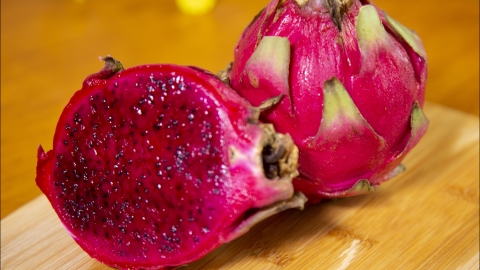Why does red-fleshed dragon fruit cause red-colored stool?
Generally, red dragon fruit (Hylocereus polyrhizus) may cause red-colored stools due to factors such as unabsorbed pigments, rapid digestion, hemorrhoidal bleeding, rectal polyps, or ulcerative colitis. It is recommended to seek timely medical consultation to determine the exact cause and receive appropriate treatment under a physician's guidance. Detailed explanations are as follows:

1. Unabsorbed pigments: Red dragon fruit contains a large amount of betalain pigments, which cannot be completely absorbed or metabolized by the human body. These pigments are excreted through feces, causing red-colored stools. This typically occurs without symptoms such as abdominal pain or diarrhea, and stool color usually returns to normal within 1-2 days after discontinuing consumption. No special treatment is required; simply reduce intake of red dragon fruit, monitor changes in stool color, and drink more water to promote pigment excretion.
2. Rapid digestion: After consuming red dragon fruit, increased gastrointestinal motility may shorten the retention time of food in the intestines, leading to incomplete metabolism of pigments before excretion. This results in red-colored stools, sometimes accompanied by slightly increased bowel movements but no other abnormalities. Avoid consuming red dragon fruit on an empty stomach, chew food thoroughly during meals, prolong digestion time, and allow the intestines to adequately process food to reduce direct pigment excretion.
3. Hemorrhoidal bleeding: Individuals with pre-existing hemorrhoids may experience rupture and bleeding of hemorrhoidal tissue during defecation, causing bright red blood to mix with stool. This can be mistaken for red-colored stools caused by red dragon fruit. Symptoms such as anal pain or itching may also occur, particularly during bowel movements. Patients should avoid prolonged sitting, maintain regular bowel movements, and use medications such as Ma Ying Long Musk Hemorrhoid Ointment, Gang Tai suppository, or Compound Carrageenan suppository as directed by a physician to alleviate hemorrhoid symptoms and reduce bleeding. In severe cases, surgical removal of the hemorrhoids may be necessary to stop the bleeding.
4. Rectal polyps: The mucosal surface of rectal polyps is fragile and may bleed during defecation due to friction. Blood adheres to the surface of the stool, appearing bright red and resembling red-colored stools caused by red dragon fruit. This may be accompanied by changes in bowel habits, such as increased frequency. Patients should promptly seek medical evaluation to determine the nature of the polyps and undergo endoscopic removal as directed by a physician to prevent bleeding. Regular follow-up examinations after surgery are necessary to prevent recurrence.
5. Ulcerative colitis: Ulcers on the colonic mucosa may bleed during defecation, leading to blood or mucus-filled pus in the stool, which appears dark red or bright red. This can be easily confused with red-colored stools caused by food. It may also be accompanied by symptoms such as abdominal pain, diarrhea, and tenesmus. Patients should avoid spicy or irritating foods and take medications such as Mesalazine enteric-coated tablets, Oxazepam sodium capsules, or Prednisolone tablets as directed by a physician to control inflammation and reduce bleeding. In severe cases, partial colectomy may be required to remove the affected intestinal segment and improve symptoms.
After consuming red dragon fruit, if stools turn red without other discomforts, discontinue consumption and observe for 1-2 days. If the stool color returns to normal, there is generally no cause for concern. Maintain a balanced diet, avoid excessive consumption of any single food at once, establish regular bowel habits, and monitor changes in stool color and consistency. If red-colored stools persist or are accompanied by abdominal pain, bleeding, or other symptoms, seek prompt medical evaluation and appropriate management.








